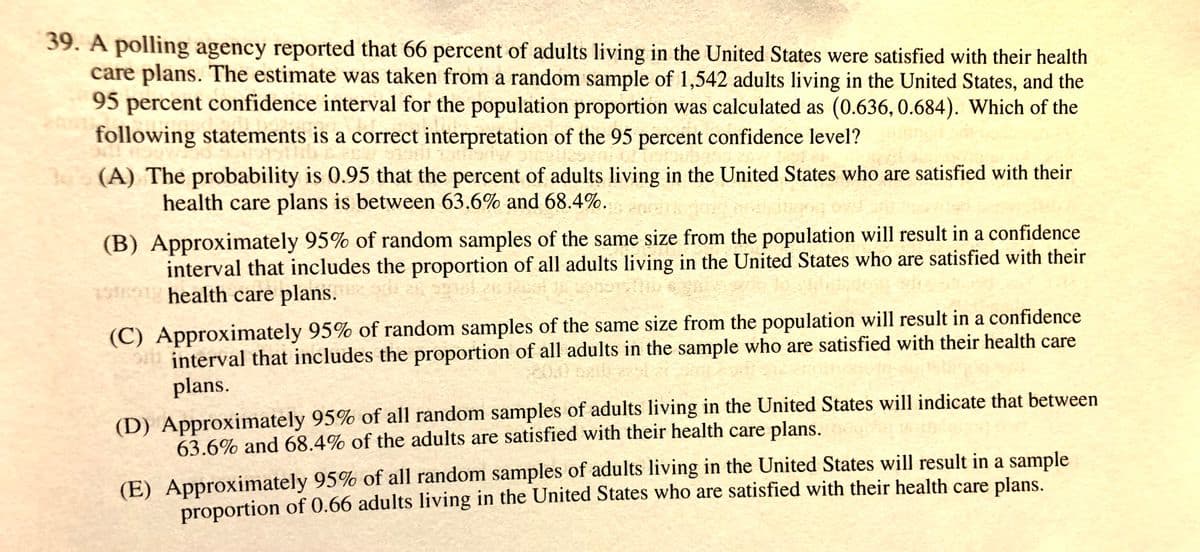A polling agency reported that 66 percent of adults living in the United States were satisfied with their health care plans. The estimate was taken from a random sample of 1,542 adults living in the United States, and the 95 percent confidence interval for the population proportion was calculated as (0.636, 0.684). Which of the following statements is a correct interpretation of the 95 percent confidence level? (A) The probability is 0.95 that the percent of adults living in the United States who are satisfied with their health care plans is between 63.6% and 68.4%. (B) Approximately 95% of random samples of the same size from the population will result in a confidence interval that includes the proportion of all adults living in the United States who are satisfied with their 19 health care plans. (C) Approximately 95% of random samples of the same size from the population will result in a confidence interval that includes the proportion of all adults in the sample who are satisfied with their health care plans. (D) Approximately 95% of all random samples of adults living in the United States will indicate that between 63.6% and 68.4% of the adults are satisfied with their health care plans. (E) Approximately 95% of all random samples of adults living in the United States will result in a sample proportion of 0.66 adults living in the United States who are satisfied with their health care plans.
A polling agency reported that 66 percent of adults living in the United States were satisfied with their health care plans. The estimate was taken from a random sample of 1,542 adults living in the United States, and the 95 percent confidence interval for the population proportion was calculated as (0.636, 0.684). Which of the following statements is a correct interpretation of the 95 percent confidence level? (A) The probability is 0.95 that the percent of adults living in the United States who are satisfied with their health care plans is between 63.6% and 68.4%. (B) Approximately 95% of random samples of the same size from the population will result in a confidence interval that includes the proportion of all adults living in the United States who are satisfied with their 19 health care plans. (C) Approximately 95% of random samples of the same size from the population will result in a confidence interval that includes the proportion of all adults in the sample who are satisfied with their health care plans. (D) Approximately 95% of all random samples of adults living in the United States will indicate that between 63.6% and 68.4% of the adults are satisfied with their health care plans. (E) Approximately 95% of all random samples of adults living in the United States will result in a sample proportion of 0.66 adults living in the United States who are satisfied with their health care plans.
College Algebra (MindTap Course List)
12th Edition
ISBN:9781305652231
Author:R. David Gustafson, Jeff Hughes
Publisher:R. David Gustafson, Jeff Hughes
Chapter8: Sequences, Series, And Probability
Section8.7: Probability
Problem 58E: What is meant by the sample space of an experiment?
Related questions
Question
#39 A

Transcribed Image Text:39. A polling agency reported that 66 percent of adults living in the United States were satisfied with their health
care plans. The estimate was taken from a random sample of 1,542 adults living in the United States, and the
95 percent confidence interval for the population proportion was calculated as (0.636, 0.684). Which of the
following statements is a correct interpretation of the 95 percent confidence level?
30 (A) The probability is 0.95 that the percent of adults living in the United States who are satisfied with their
health care plans is between 63.6% and 68.4%.
(B) Approximately 95% of random samples of the same size from the population will result in a confidence
interval that includes the proportion of all adults living in the United States who are satisfied with their
1901 health care plans.
(C) Approximately 95% of random samples of the same size from the population will result in a confidence
interval that includes the proportion of all adults in the sample who are satisfied with their health care
plans.
(D) Approximately 95% of all random samples of adults living in the United States will indicate that between
63.6% and 68.4% of the adults are satisfied with their health care plans.
(E) Approximately 95% of all random samples of adults living in the United States will result in a sample
proportion of 0.66 adults living in the United States who are satisfied with their health care plans.
Expert Solution
This question has been solved!
Explore an expertly crafted, step-by-step solution for a thorough understanding of key concepts.
This is a popular solution!
Trending now
This is a popular solution!
Step by step
Solved in 2 steps

Recommended textbooks for you

College Algebra (MindTap Course List)
Algebra
ISBN:
9781305652231
Author:
R. David Gustafson, Jeff Hughes
Publisher:
Cengage Learning

College Algebra (MindTap Course List)
Algebra
ISBN:
9781305652231
Author:
R. David Gustafson, Jeff Hughes
Publisher:
Cengage Learning